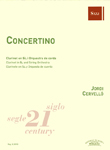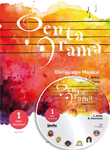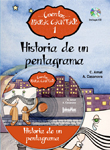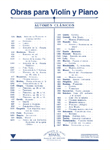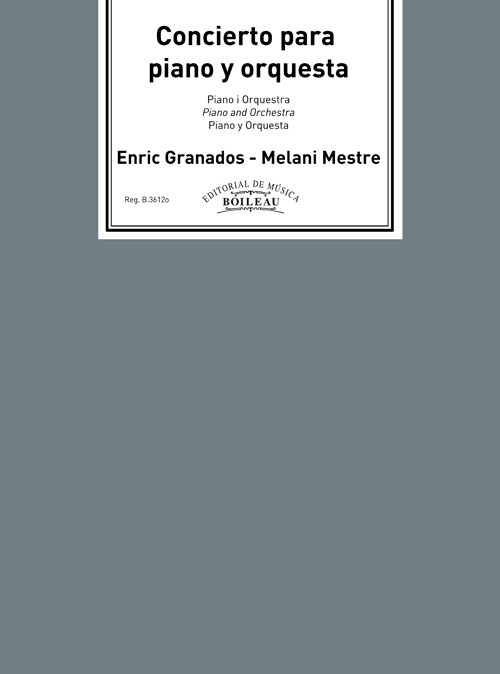Concierto para piano y orquesta
Materiales de orquesta sinfónica en alquiler
Piano y Orquesta sinfónica
GRANADOS, EnricReg.: B.3612o
- Arrangement: MESTRE, Melani
- Review: MESTRE, Melani
- Ensemble: Symphonic orchestra: With soloist(s).
- Genres: Classical / contemporary: Symphonic.
- Product format: Partitura
- Difficulty level: Advanced-superior
- Period: 2nd half S. XX - XXI
- Publishing house: Editorial Boileau
- Collection: Siglo XXI
- No. of pages: 160
- Measure: 29,70 x 21,00 cm
- Lenght: 35'10"
- ISMN: 979-0-3503-0845-1
- Available in digital: No
- Available for rent: Yes
Solo Piano
2 3[1.2.Eh] 3[1.2. bcl] 2 — 4 2 3 1 — tmp+3 — hp — str
perc: bd, cym, tri, glock, cast, woodblk
Cuerdas: 7,6,5,4,3
Historical considerations:
Enrique Granados is internationally esteemed as one of the most important composers in Spanish musical nationalism in the second half of the 19th century, and is recognised as one of the greatest pianists in the world from the piano golden age. Along with Ricard Vinyes, Joaquim Malats and Isaac Albéniz, he is representative of Spanish piano at the end of the 19th and beginning of the 20th centuries. However, what is unfortunately less well-known is his side as a composer of symphonic music. Nearly 100 years after his tragic disappearance, Granados’ orchestral music remains completely unknown, unpublished and surprisingly untouched. Nevertheless, this has a historical explanation that leaves an impression on us.
Towards the end of the 19th century, most Spanish composers/musicians such as Granados were forced to compose a sort of pieces that were suited to the demands of the public at that time. Such audience preferred music in private salons and cafés, where musicians such as Granados, Casals, Malats and Vidiella played their pieces to accompany long soirées and chats among the wealthy society of that time.
Such society was not ready to hear pieces with a large repertoire, since this was not at all appropriate for the main purpose that the so-called serious or cultivated music served in those days. Large format music such as sonatas or concertos were usually too erudite in content to satisfy the often simply commercial needs of the most bourgeois cafeterias of the time, which hired string quartets or pianists to amuse their clientele and thereby increase their establishment’s volume of business. Granados was not able to escape this fashion, which became a need since it in some way helped him to earn a living, as in many other cases, and in specific cases of extreme need it helped his family financially.
Nor should we forget that the musical subscriber magazines demanded that the works they published should be enjoyable for their readers. They were usually written for the piano and were of a limited duration if not short, which enabled them to be inserted between artistic and musical news of the time. This is how many of the works were born that Granados dedicated to his instrument: the piano. In some cases there are even collections of works such as the famous Danzas Españolas (Spanish Dances), or the Escenas Románticas (Romantic Scenes), Valses Poéticos (Poetic Waltzes), etc. However, this format began to change definitively when Enrique Granados was able to create his own music school, the Academia Granados, which opened in 1901. This provided him with enough financial stability so as not to depend on the stylistic and formalistic demands of the works that until then had given him his basic income for his family’s economy.
As of the moment Granados became involved in his own academic structure on which to base his family’s subsistence, he set out on a new musical path that would lead him to change genres and style. For the first time there were no ties to prevent him from writing simply for himself or merely to dedicate a piece to a colleague. At last the composer side of him gained complete freedom. It was a break with the past that he had been obliged to experience until then.
It was then that Granados began to write for orchestra and even his own works for piano became more orchestral than ever. The climax of this trend can be seen in the Suite for piano that later became his Opera Goyescas which would catapult him to worldwide fame after its first performance in New York’s Metropolitan Opera House the year he died, 1916.
Nevertheless, it is curious that most of Granados’ orchestral works written as of 1900 are still unpublished. Nor have any been published until today, with the exceptions of Goyescas, the symphonic poem Dante and some lesser lyrical works such as El Fullet.
The fact is that due to the lack of publications, editions and performances of his orchestral and chamber works, Granados has earned unjustified fame as a composer of works for the piano who did not have either the sufficient knowledge or skill to take on large format works or simply orchestral works. This is entirely false. Once I had the chance to study Granados’ symphonic work in depth, I came to the evident conclusion that all of these fallacies and ideas about him have no foundation at all.
The case we are concerned with, his First Concerto for Piano and Orchestra, subtitled with the sobriquet of “Patético”, is a clear example of this.
Granados was not only very knowledgeable about forms, as demonstrated by the fact that the concerto’s first movement alone lasts nearly twenty minutes, but his treatment of the orchestration and his concept of the concerto genre, apart from being very idiosyncratic, are totally different from what Granados had written till then. This entailed the need to perfectly master orchestral writing, as well as the treatment and knowledge of the instruments and orchestration. He had acquired these facets thanks to his personal experience as a soloist pianist and at that time also as an educator through the concertos by Beethoven, Chopin, Liszt, Saint-Saens, etc. that he made his students study.
The reviewer’s considerations:
The finding of the unpublished manuscript that Granados named Primer Concierto para Piano y Orquesta (First Concerto for Piano and Orchestra), conserved in the archives of the Music Section of the Library of Catalonia in Barcelona and recently catalogued within the Fondo Granados fund, is the most important musicological proof that provides the chance not only to re-write Granados’ biography but also to define, consider and properly catalogue the work of one of the greatest international composers that our country has produced.
Most interesting of all, however, is being able to do justice to a work that Granados dedicated to his colleague and great friend, the composer Camille Saint-Saens. He had actively collaborated with him in 1908 and was not able to finish due to important commissions he received as of 1911 with regard to the Opera Goyescas, which kept him busy until the opera’s first performance. His unexpected death in 1916 definitively cut short this project.
Therefore, that date the concerto for piano was composed was most certainly in the years 1909-1910, just after playing Concerto no. 5, The Egyptian, by Saint-Saens, conducted by the composer himself. To show his thanks, he dedicated what he hoped would be the “First” Concerto for Piano.
The original manuscript, made up of three separate documents, is in the custody of the National Library of Catalonia. There are two scores for two pianos, one of which is far more complete (this comes up to the beginning of what he called the second movement with Roman numerals), and another orchestra score that contains 70 bars in which the orchestral template can clearly be seen. At first they appear to be three different documents, but when they are studied in detail one can see that they fit perfectly since the bars that Granados left blank in the orchestra score are exactly complemented by the piano part of its holographic score for two pianos that reflect the orchestral reduction.
This manuscript is the one that I have used to deduce where the first movement ended and where the second began. Only one page in pencil has survived from it, which is not enough material to develop a second movement as Granados intended.
In order to give it a definitive form in three movements as was usual in any romantic concerto of the time and which also seems to have been Granados’ intention, I have opted for the solution of including a second and third movement using works for the piano by Granados. These works are "Oriental" Dance No. 2 and Capricho español (Spanish caprice), which make up the second movement, and Allegro de Concierto, which is the third.
Given the musical content of the first movement and the style, duration and influences that may be found in it (Liszt, Chopin, Schumann), I considered that the most suitable pieces to complete the concerto structure should be those that least express the feeling and spirit of Spanish nationalism so closely bound to Granados’ piano style and genre.
The fact that the first movement was left alone, just as it is, is not due to Granados’ artistic composer’s desire, which he clearly indicates in his Andante manuscript that corresponds to the second movement that he did not finish. The fact that Granados did not finish the orchestration and left the first movement’s ending unfinished, though making an explicit reference to “attacking” the second without a rest, obliged me to use a magnifying glass to follow the sketch that can more or less be made out between the pages that he left completely blank until the first and only page of the second movement.
The criteria I have used when drawing up the end of the first unfinished movement, as well as the lack of orchestration and indicators that may have provided some other solution to the problem, are based on matters of harmony, melody, counterpoints and structures that scrupulously observe the number of bars that Granados gave as an exact guideline until the double bar line that indicates the end of the first movement and the start of the second.
Due to the type of ending proposed by Granados and the lack of material that prevents it from being linked to the second, I decided not to connect Granados’ first movement to the second; I wrote over the composer’s music myself. In this way it is much clearer that 90 % of the first movement is by Granados and that all the rest is there to balance the work’s structural sense to respect the wish of the composer to write more than one movement. The result is thus a finished work that can be presented in public with logical, coherent musical sense which follows widely known and internationally accepted musical restoration and musicological techniques.
Melani Mestre
Barcelona, May 2010
I. Concert pur Piano et Orchestre "Patético" (18'50") II. Danza Española nº 2 Oriental / Capricho Español (7'40") III. Allegro de Concierto (8'40")


